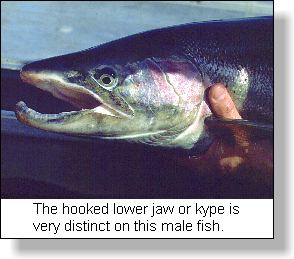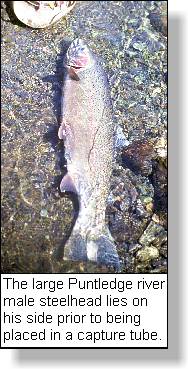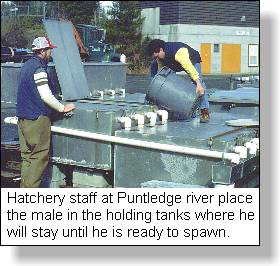
Steelhead fishing series
"STEELHEADING TIPS;
PLAYING THAT RIVER TROPHY!"
with Barry M. Thornton
As I walked the fish up to the head of
the pool, I was startled by the question;
"Why don't you just reel?"
It came from an angler who was watching
every move I made as I fought a beautiful rainbow hued
wild steelhead buck. It was a strong fish and, as he tore
against the line, time and time again, I had many
opportunities to explain to my intent observer, whom I
learned was a novice at steelheading , my successful
tactics against these magnificent powerful fish.
 "Above all else," I told him,
"I use the pool to my advantage. Before I even hook
a fish I make a mental image of all hazards and currents
which a fish could use to his advantage and then plan my
strategy against it."
"Every steelhead pool has 5 basic
sections," I explained, as the buck made short
dashes, "the two shoreline shallows on each side;
the tailout shallows where the water flows out of the
pool; the shallow headwaters where the river enters the
pool; and the actual deep water of the pool, either as a
trough created by sloping banks, or a wide depression in
the river."
In this particular pool, there was a
deep trough immediately below the head of the pool which
was enlarged by a shoreline backeddy. It was to this
backeddy that I was walking the buck so that he would
think he was running downstream when in reality, while he
faced downstream because of the flow of the backeddy, his
'downstream' run was actually a run to the head of the
pool. As long as I could keep him in this location, I
would have a chance to tire him before he swam into the
main current to swim over the downstream log jam where he
was certain to escape.
 "Walking a steelhead upstream is a skill
used by most steelheaders," I assured the angler.
"First , you reel your line tight to the fish and
then, with rod bent at the fish, you slowly walk upstream
pulling the fish up the pool. This method stops the
irritating jerking caused when you reel, and, appears to
give the fish some sense of control. But, be prepared in
case he suddenly begins a run. By having a bend in your
rod there will not be a sudden start which could break
your leader." "Walking a steelhead upstream is a skill
used by most steelheaders," I assured the angler.
"First , you reel your line tight to the fish and
then, with rod bent at the fish, you slowly walk upstream
pulling the fish up the pool. This method stops the
irritating jerking caused when you reel, and, appears to
give the fish some sense of control. But, be prepared in
case he suddenly begins a run. By having a bend in your
rod there will not be a sudden start which could break
your leader."
"I have beached many hundreds of
steelhead in my years of hunting these magnificent
trophies," I told the angler who was now being most
helpful by giving me a three point stance by holding my
coat up in the fast water at the head of the pool; "
but, it is the initial reaction of the fish when he
realises that he has been hooked, when I am most tense.
Like aircraft landings and takeoffs, the most hazardous
times, it is the strike and beaching that are the most
telling!"
"The first questions that flash
through my mind," I continued, "are directed to
my tackle and the fish!"
"Will the hook hold? Will he go
upstream or down?"
At that moment the buck broke water,
tailwalking away from me as he fought the pull off my
line.
"Easy, easy!", I exclaimed,
easing off on the thumb pressure I was applying on the
single action fly reel.
"When he runs, let him go! Too
often a good fish has snapped my leader simply because I
applied too much pressure during these panic surges. Let
the rod tire the fish!"
"Tight lines! is more than just a
farewell to your fellow anglers, it is the technique you
must master if are to finally beach your trophy."
"Remember," I told him, "a hooked fish is
constantly trying to work the hook out of it's mouth. It
does this by rolling it's jaws, working at the hook with
it's tongue and by rubbing the hook on bottom gravel and
rocks. A moment of slack usually means a lost fish!"
"Will he go upstream or down? This is the primary
action of the fish," I told the attentive angler,
"which demands immediate attention! Usually a
steelhead is hooked in the tailout of a pool. Its first
reaction is to escape and this it does by using the
natural element where it exists. High water and fast
flows will usually enable the fish to dash out of the
pool and head downstream."
 "This is the origin of the steelheader's
call, "FISH ON!" "This is the origin of the steelheader's
call, "FISH ON!"
"If I can keep the fish in the
pool successful beaching is almost assured. But,
steelhead don't always co-operate. If my fish runs
downstream I quickly strip line off my reel to create a
downstream belly in my line. When he feels the downstream
line pull the fish will often halt and slowly begin to
swim back upstream. I wait until the fish is once more
holding in the pool before I reel in slack line. To
ensure that the hook is not slack in the mouth I will
keep my rod tip pointed downstream, flat to the river, in
the water."
By this time I had the buck in front of
me and was beginning to reel him closer and closer to the
gravel beach. Over my shoulder I carried a fish tube. I
was determined that this wild beauty was destined for
future hatchery stock! I asked the attentive angler to
take it and slip out one end into which I could guide the
buck.
I constantly chattered to the novice as
I made each adjustment to this powerful fish. I then
highlighted those key elements which need to be
considered once you have the fish pooled.
"Keep a firm pressure on the fish
but let the rod tire him!"
"Keep the rod tip up!"
"Remember to 'bow-to-the-fish'
when he leaps!"
"Watch for beachside snags."
"Watch that your line is not
frayed by instream boulders or ledges"
"Be careful of the streamside
canopy which could hinder your rod"
 This was a particularly important steelhead. I
was fishing on the Puntledge River using a most
successful 'Campbell Pink' pattern, particularly
effective in clear waters. A large male was needed at the
hatchery for the winter steelhead program and this fish
was perfect. This was a particularly important steelhead. I
was fishing on the Puntledge River using a most
successful 'Campbell Pink' pattern, particularly
effective in clear waters. A large male was needed at the
hatchery for the winter steelhead program and this fish
was perfect.
By this time I had the fish tired to
the point where it lay up on it's side in the shallow
water.
"Never ever," I emphasized,
"underestimate the skills of a steelhead for escape!
I have lost more fish at the beach when I get too anxious
and careless! Now, I make certain that he is well played
out then slowly ease him to a shallow section where he
can be released or, brought up on an open beach if he is
to be a keeper."
By now the buck was on his side near my
waders. I slowly reached down and with care, eased him
head first into the plastic tube. Dropping the lid, I
snapped the lock in place. Together we walked to the
hatchery where hatchery staff brought the tank truck to
transport the fish to the steelhead holding condominiums.
© Copyright Barry M. Thornton
Barry M. Thornton
| 




 "Walking a steelhead upstream is a skill
used by most steelheaders," I assured the angler.
"First , you reel your line tight to the fish and
then, with rod bent at the fish, you slowly walk upstream
pulling the fish up the pool. This method stops the
irritating jerking caused when you reel, and, appears to
give the fish some sense of control. But, be prepared in
case he suddenly begins a run. By having a bend in your
rod there will not be a sudden start which could break
your leader."
"Walking a steelhead upstream is a skill
used by most steelheaders," I assured the angler.
"First , you reel your line tight to the fish and
then, with rod bent at the fish, you slowly walk upstream
pulling the fish up the pool. This method stops the
irritating jerking caused when you reel, and, appears to
give the fish some sense of control. But, be prepared in
case he suddenly begins a run. By having a bend in your
rod there will not be a sudden start which could break
your leader." "This is the origin of the steelheader's
call, "FISH ON!"
"This is the origin of the steelheader's
call, "FISH ON!" This was a particularly important steelhead. I
was fishing on the Puntledge River using a most
successful 'Campbell Pink' pattern, particularly
effective in clear waters. A large male was needed at the
hatchery for the winter steelhead program and this fish
was perfect.
This was a particularly important steelhead. I
was fishing on the Puntledge River using a most
successful 'Campbell Pink' pattern, particularly
effective in clear waters. A large male was needed at the
hatchery for the winter steelhead program and this fish
was perfect.